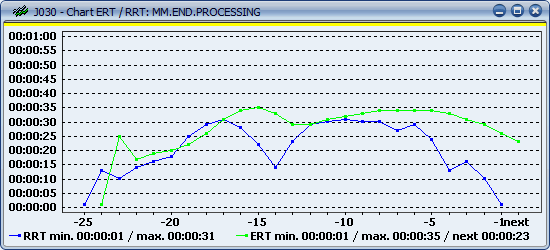
|
Real Runtime (RRT) |

Runtime Evaluation |
Methods of Runtime Evaluation |

|
The estimated runtime (ERT) is the expected time for the next execution of a task. The abbreviation ERT stands for Estimated Runtime.
The ERT itself is calculated from the real runtime (RRT) of the last 25 properly executed task runs. It is the central value for dynamic runtime monitoring and forecast calculations, and for calculating the most recent ending of a task.
The quality of the ERT calculation is dependent on the available data. In case of a reorganization of the databaseA database is an organized collection of data including relevant data structures. there could be not enough datasets available. The calculation might be wrong in this case.
A lot of statistical data will be read from the object for the calculation. Therefore this function should be only activated for individual objects, not client-wide.
The estimated runtime is calculated immediately after the task's run by using its last and the previous RRTs. The way how the time is specified depends on the selected dynamic method. It should provide a highly realistic runtime for the next activation of a task.
If does not often occur that a task runs and ends several times at the same time. In this case it could happen that one of the executions is not included in the ERT calculation. This happens because of the locking mechanisms that are provided in the AE database.
If you want to use the estimated runtime for your runtime monitoring, note that the definitions for this evaluation should always be set below the estimated runtime. In doing so, you can avoid alarm that are not necessary, for example.

You can have the saved estimated runtimes be displayed in a diagram, and you can compare the estimated runtimes and the real runtimes - the latter beginning one position to the left. The diagram begins with the "oldest" real runtime and ends with the estimated runtime of the next run.
Default settings
for all clients
The following program settings apply unless you provide other specific other settings on how to evaluate the estimated
runtimes:
Central settings
for a single client
For a single client, you can specify the evaluation method in its AE variable "UC_CLIENT_SETTINGS". The specified values then apply for the calculation
for all the client's objects in which "Use default" is selected
in their Runtime tab.
Settings in individual
objects
In all executable objects, you can specify the evaluation method for the estimated runtime
in their Runtime tabs.
Directly entering the ERT
You can directly enter the estimated runtime of a task if there is no existing runtime data for it (for example, if you are using a new task, or the runtime data has been reset). This value will then be considered
for forecast calculations and runtime monitoring. It will be overwritten as soon as the task has completed its first run and replaced by the ERT value that can now be calculated according to the specified method.
Fixed value
No current runtime data of the object is required if you select a static setting. In this case, a fixed value will be used for the estimated runtime. You can specify this value in the object's Runtime tab (value in seconds).
Average
This means that the average value will be retrieved from the real runtimes. You can also define the number of previous
runs that should be considered, or define a correction
factor in percent that will be added to the calculated average
value.
Linear regression
This method puts emphasis on runtime increases or decreases. You can also define the number of previous runs that should be considered, or define a correction factor in percent.
Maximum value
The highest value from the list of real runtimes is used as the
estimated runtime.
Adaptive
This method calculates the ERT proactively by considering various factors and runtime parameters such as the start time and the task's agent.
You can use the Reset button in order to delete all your runtime data. An additional security query needs to be confirmed before all the existing RRTs and ERTs will be deleted and the current ERT is set to zero.
Note that your data will even be deleted if you do not save the object that you edit. You cannot restore real runtime data from archived data.
Once you have reset your runtime date, you can again directly enter the estimated runtime and this value will be overwritten as soon s the task has completed its first run.
Resetting the saved runtimes is only useful if you expect major runtime deviations for future runs (for example, you have changed the task).